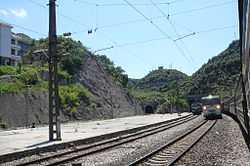Shanghai–Kunming Railway
The Shanghai–Kunming Railway or Hukun Railway (simplified Chinese: 沪昆铁路; traditional Chinese: 滬昆鐵路; pinyin: hùkūn tiělù), also known as the Hukun Line, is a major arterial railroad across eastern, south central and southwest China. It connects Shanghai, whose shorthand name is Hu, and Kunming. The line has a total length of 2,690 km and passes through Shanghai Municipality, Zhejiang, Jiangxi, Hunan, Guizhou and Yunnan Province. Major cities along route include Shanghai, Jiaxing, Hangzhou, Yiwu, Jinhua, Shangrao, Yingtan, Pingxiang, Zhuzhou, Huaihua, Kaili, Guiyang, Anshun, Qujing, and Kunming.
Line Description
The Hukun Line is double track from Shanghai's South Station to Liupanshui and single-track railway for about 400 km from Liupanshui to Kunming. The speed limit for Hukun Line is 200 km/h from Shanghai to Zhuzhou and it is 120 km/h from Zhuzhou to Huaihua. The entire line is electrified.
The Shanghai–Kunming High-Speed Railway, presently under construction, runs generally parallel to the Shanghai–Kunming Railway.
History

The Shanghai–Kunming Railway has four major segments, which were built over a span of 70 years. In 2006, after the Ministry of Railways rebuilt sections along route and increased train travel speed, the four lines were collectively referred to as one.
- Shanghai-Hangzhou Railway (Huhang Line simplified Chinese: 沪杭铁路; traditional Chinese: 滬杭鐵路; pinyin: Hùháng Tiĕlù), 189 km in length, was built between 1906 and 1909 and connects Shanghai and Hangzhou.
- Zhejiang-Jiangxi Railway (Zhegan Line simplified Chinese: 浙赣铁路; traditional Chinese: 浙贛鐵路; pinyin: Zhègàn Tiĕlù), 946 km in length, was built between 1899 and 1926 and connected Hangzhou, the capital of Zhejiang Province, with Zhuzhou, in northern Hunan province.
- Hunan-Guizhou Railway (Xiangqian Line simplified Chinese: 湘黔铁路; traditional Chinese: 湘黔鐵路; pinyin: Xiāngqián Tiĕlù), 905 km in length, was begun in 1937, halted in 1939 by World War II, restarted in 1953 and completed in 1975. It runs from Zhuzhou to Guiyang, capital of Guizhou Province.
- Guiyang-Kunming Railway (Guikun Line simplified Chinese: 贵昆铁路; traditional Chinese: 貴昆鐵路; pinyin: Guìkūn Tiělù), 639 km in length, was built between 1958 and 1970, and connects Guiyang and Kunming. It was electrified in 1980.
Accidents
On May 23, 2010 (UTC+8), passenger train derailed after heavy rains caused mudslides on the Hukun Line in Jiangxi Province, killing 19 passengers and injuring 71.[1]
See also
- List of railways in China